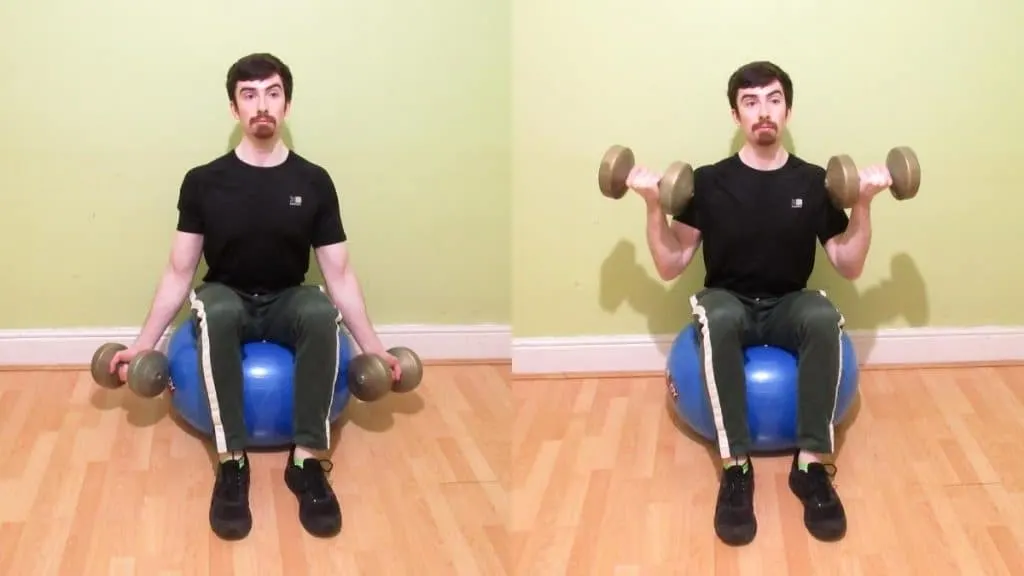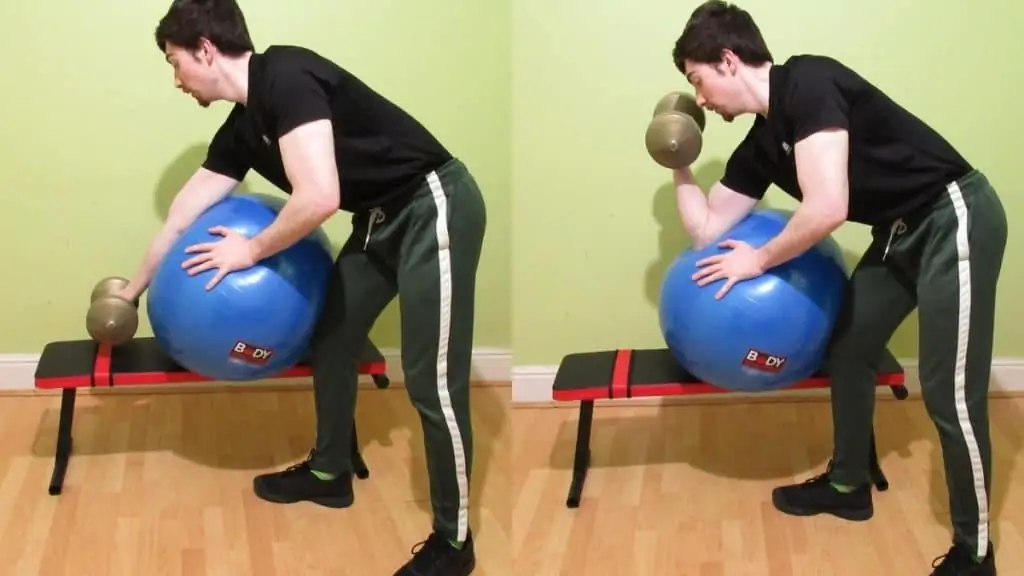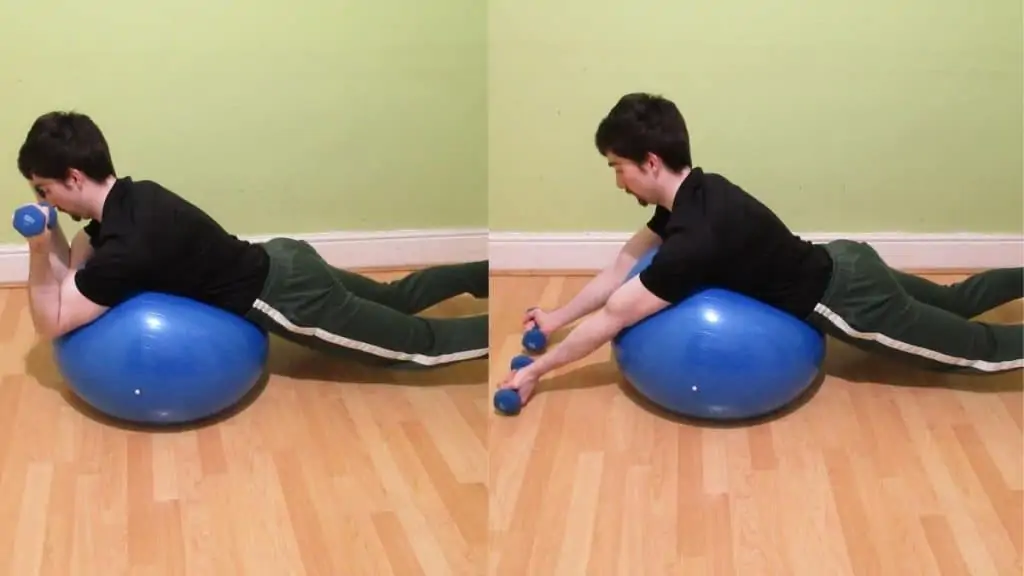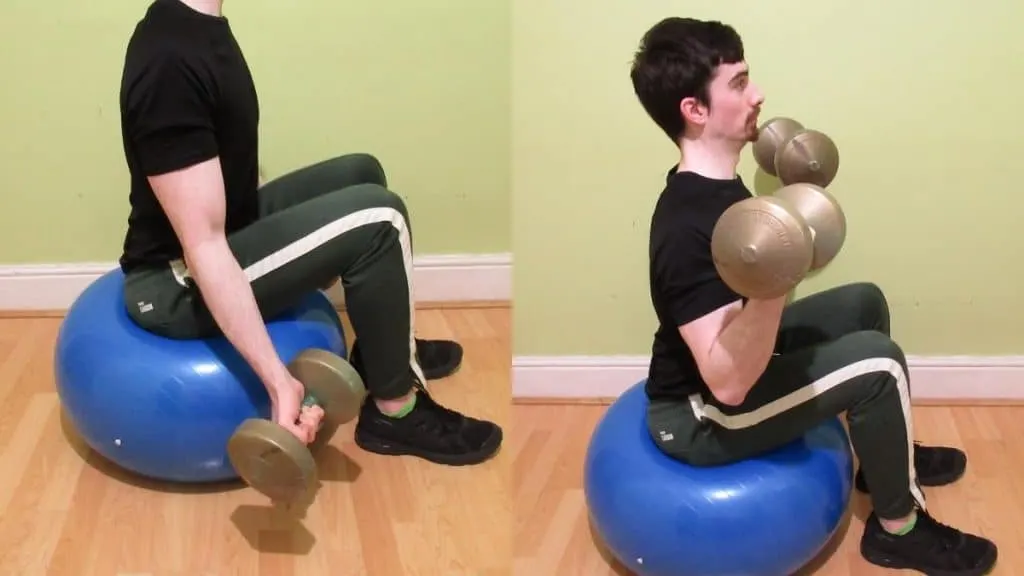Your bicep muscles are important because they help you to pick up all manner of objects in everyday life, and they also stabilize the shoulder joint during other upper body exercises.
The Swiss ball bicep curl and its variations (more on those later) is a safe and effective movement for strengthening your biceps and improving your core stability without the need for any fancy gym equipment.
Related Exercise: Door curls
Swiss ball bicep curl exercise details
- Also Known As: Exercise ball bicep curl
- Main Muscles: Biceps brachii
- Secondary Muscles: Brachialis, brachioradialis, forearm flexors, abs
- Exercise Type: Strength
- Exercise Mechanics: Isolation
- Difficulty Level: Beginner
- Equipment Needed: Exercise ball, dumbbells
How to do Swiss ball bicep curls

- Grab two dumbbells with an underhand grip and then sit on an exercise ball.
- Sit up straight and tighten your core to stabilize your upper body.
- With your elbows close to your sides, curl the weights toward your shoulders while keeping your elbows still.
- Keep lifting until the undersides of your forearms make firm contact with your biceps.
- Hold the contraction for a moment.
- Lower the weights under control until your elbows are completely locked out.
- Repeat for 3-5 sets of 8-15 reps.
Other exercise ball bicep exercises
These exercise ball bicep exercises challenge your muscles from different angles and add variety to your workout routine. You can perform all of them in the same session to really blast your biceps, or you can split the movements up over different days of the week to increase your training frequency.
Single arm exercise ball bicep curl

To do this exercise ball biceps curl, you’ll need a weight bench, a dumbbell, and a balance ball. It feels a lot like a preacher curl because you’re bracing your arm against the ball, which prevents you from swinging the weight up with other muscles.
Yet, because you’re doing the drill on a balance ball (which is inherently unstable), the stabilizer muscles in your biceps are naturally much more active, which means that you may actually increase your overall bicep stimulation as well.
Begin by grabbing a dumbbell and then position your exercise ball on top of a weight bench. Brace the arm that’s holding the dumbbell against the ball. Hold onto the ball with your other arm as well in order to keep it stable.
Lower the dumbbell until your elbow is fully extended. From this stretched position, curl the weight toward your front delt and squeeze your biceps as your forearms press up against them. Hold the contraction briefly, and then lower the dumbbell under control until your arm is once again locked out. Switch arms and repeat for 3-5 sets of 8-15 reps per side.
Lying exercise ball curl

If you want to focus on the peak contraction of your biceps, this supine variation of the Swiss ball bicep curl is an excellent choice. To perform it, you’ll need an exercise mat, a pair of weights, and, of course, a balance ball.
Lie on the exercise ball with your stomach and rest your arms over the other side of the ball. You can also train one arm at a time if it’s easier.
Start by lowering the weights toward the ground. Once your elbows reach full extension, reverse the motion and lift the dumbbells toward your shoulders by flexing your biceps. Hold the contraction for a second and then repeat the movement for 3-5 sets of 8-15 reps.
You can also try the various medicine ball exercises for the biceps if you want to work your arms with another convenient piece of equipment. Alternatively, you could do the towel curl exercise if you can’t get to a gym and don’t have any weights.
In conclusion

As you can see, there are multiple ways to do bicep curls on a Swiss ball. The first choice that you saw in the how-to section is easier because you’re sat up straight (meaning that you can lift heavier). It also places the greatest demand on your core muscles.
The other two variations are very similar. Both versions have you curl with your arms in front of your body, which shifts the emphasis onto the inner muscle fibers of your biceps and helps to intensify the peak contraction at the top of the rep.

